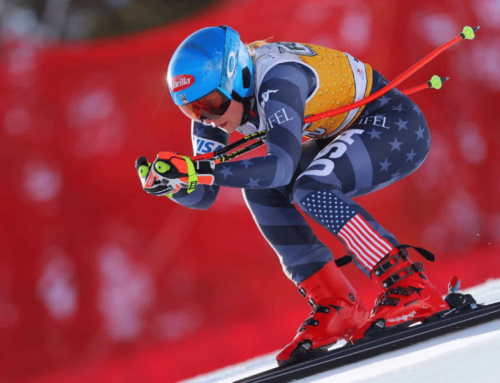The Non-Existent Case for Stretching
Next week, the eyes of the world will be on Brazil as the Rio 2016 Summer Olympics unfold. Spectators will watch in awe as swimmers and runners beat world record times and gymnasts land nearly impossible tumbling passes. While a lack of snow may leave ski racers puzzled as to what can be learned from these summer sport athletes, basic athleticism is not confined to a 10.0 judging scale or the length of a slalom course.
One basic key of athleticism is flexibility, and in conjunction with that, mobility. It’s a characteristic that rhythmic gymnasts have in mass (see Exhibit A), but it’s something often pushed aside in favor of agility and strength for alpine skiing athletes.

EXHIBIT A: Rhythmic gymast, Anika Nachbaur, shows off her flexibility (left), while Lindsey Vonn shows off her mobility and balance in the Torino Olympic slalom (right).
J.P. Daigneault is the alpine program director at the Northwood School in upstate New York, and he admits that flexibility is not always the focus of his conditioning programs.
“Flexibility gets on the radar when an athlete has a functional limitation,” he explains. “For example, in order to do a safe and effective pistol squat, a certain amount of flexibility is required.”
That’s not to say that Daigneault and other professionals who work with ski racers don’t see the value in stretching, but as he puts it: “We don’t think that increased flexibility is the key to getting an athlete from 100 FIS points to 50 FIS points.”
And that may be true. An athlete’s hip flexibility may not make or break a ski career, but stretching and mobility are key to properly doing the exercises that will get an athlete in shape. Stretching is part of the larger equation – just like tuning a pair of skis.
Sport scientist Troy Taylor is the high-performance director for USSA. Hailing from the United Kingdom, Taylor has spent his life dedicated to exercise science, earning a bachelor’s and master’s degree in the field before joining USSA early in his career. He works with the top ski racers in the United States on their conditioning, and he integrates stretching into all of their workouts.
“Certainly being mobile, being able to go through a full range of motions and movements that you’re going to be doing in your sport and doing that in a dynamic fashion – so being able to do that at the speed you might be doing it in your sport – I think is absolutely essential,” Taylor says.
Integrating stretching into workouts is not as simple as it may sound, so let’s start from this beginning. Every workout should begin with a warmup, according to Taylor – something that heats up your muscles like dynamic stretching.
What is dynamic stretching? When you envision typical stretching, like a gymnast sitting stagnant in the splits or a runner pulling his foot behind his back, that’s static stretching. Dynamic stretches combine movement with stretching to activate muscles – like leg swings, lunges or arm circles – and this is much more effective for ski racers.
“Typically, we do dynamic stretching before (a workout),” Taylor says. “We do a standard warmup whether it’s jogging or spinning on a spin bike. That type of stuff followed by dynamic stretches, ideally specific to the motions or movements we’re going to be doing.”
Because the nature of dynamic stretching is that it prepares your body for the movements you’ll be doing later in the workout, the stretches athletes perform will vary by workout. Static stretching should be saved for after the completed workout. The reality is that there is no one-size-fits-all stretching routine that will be best for every athlete, and anyone putting together a stretching regimen should consider personal flexibility goals and injuries that may need extra attention.
One common misconception about stretching is that it helps to prevent injuries. A 2004 article in the Official Journal of the American College of Sports Medicine concluded that “the best available evidence indicates that stretching before or after exercise does not prevent muscle soreness or injury.”
“The research evidence would suggest that stretching doesn’t play a large role in injury prevention,” Taylor explains, continuing to say that doesn’t mean stretching isn’t important to an athlete’s fitness.
The 2004 study does state, however, that extremes of inflexibility or hyperflexibility can increase the risk of injury. Basically, while stretching may not prevent injury, not being able to touch your toes could increase your risk of getting hurt. And being only flexible without complementing it with strength and balance also isn’t going to do a ski racer much good.
“Stronger evidence demonstrates that various approaches to conditioning that include warmup and stretching along with other techniques such as strength training, plyometrics, and proprioception training both enhance performance and prevent certain kinds of injury,” states the Official Journal of the American College of Sports Medicine study. “This suggests that strength training, conditioning, and warmup play an important role in injury prevention. In addition, stretching of specific muscles and joints for specific activities might enhance the effectiveness of these other pre-exercise activities, an approach consistent with a multifactorial model for prevention.”
The research, as a whole, is rather inconclusive as to the clear benefits or negative effects of stretching with no decisive findings about its true value. A general consensus seems to be that while the value of stretching may be intangible, it is important to be integrating it into a regular fitness routine and necessary for building a well-rounded elite athlete. For junior athletes, stretching can also have more mental benefits than physical ones.
“Regular, guided yoga is part of our dryland program and post workout cool-down routines include elements of static stretching as the muscles and other soft tissues are warm and fully activated then (no static stretching at the beginning of workouts),” Daigneault shares. “The other benefit of light and purposeful stretching that we like to believe in is the calming effect it has. We think it’s a simple way to regroup from the high and fully stimulated state of a hard workout back down to calm before going back to class or whatever is next in the athlete’s busy life.”























